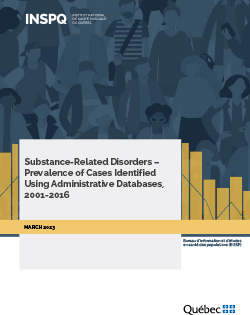This report presents the annual and cumulative prevalence of substance-related disorders (SRDs). It demonstrates the ability of the Québec Integrated Chronic Disease Surveillance System (QICDSS) to allow for the study of SRDs based on health administrative databases. Prevalences were determined based on administrative data from April 1, 2001 to March 31, 2016, for all persons eligible for coverage by the Régie de l'assurance maladie du Québec and aged 12 and older. To be identified as having an SRD, the individual must have had at least one medical visit or hospitalization resulting in a primary or secondary diagnosis of an SRD.
- Over a 15-year period, 40 individuals per 1,000 were diagnosed with an alcohol-related disorder and 39 per 1,000 with a drug-related disorder. Approximately 13 per 1,000 were diagnosed with both an alcohol-related and a drug-related disorder. Thus, 66 individuals per 1,000 were diagnosed with at least one SRD.
- The annual prevalence of SRDs remained stable during the period studied (9 per 1,000 individuals in 2015-2016), with an annual rate of 12 per 1,000 for men and 7 per 1,000 for women.
- The annual prevalence of alcohol use disorders remained stable from 2001-2002 to 2015-2016 for women aged 18 years and older, while it decreased for men aged 25 years and older for the same period.
- The annual prevalence of alcohol dependence decreased slightly from 4 to 3 per 1,000 over the 15-year period, while the prevalence of alcohol abuse remained stable (around 1 per 1,000).
- The annual prevalence of drug use disorders ranged from 3 to 4 per 1,000 from 2001-2002 to 2015-2016. Individuals aged 18-49 years showed the highest prevalence of all age groups. The annual rate appears to have been declining for 18-49-year-old in recent years; in contrast, an increase in the annual prevalence of drug use disorders is observed among adolescents.
- The prevalence of alcohol withdrawal increased until 2010-2011 and was highest among those aged 65 years and older: from 2 per 1,000 women in 2001-2002 to 3 per 1,000 in 2010‑2011 and from 2 per 1,000 men (2001-2002) to 4 per 1,000 (2010-2011). Prevalence has remained stable since then.
- The annual prevalence of alcohol-induced physical diseases remained stable and was highest among men (2 per 1,000 men aged 50-64 years and 3 per 1,000 men aged 65 years and older).
- The annual prevalence of drug-induced psychotic disorders increased slightly (from 0.4 to 0.7 per 1,000 individuals over 15 years), especially among men and among persons aged 18‑24 and 25-49 years; in contrast, the annual rate remained stable among adolescents for this sub-indicator (around 0.3 per 1,000 adolescents).
- The annual prevalence of alcohol intoxication increased from 0.3 to 0.6 per 1,000 over a 15‑year-period. The increase is most notable among 18-24-year old, among whom it increased from 0.3 to 1.0 per 1,000 for men and from 0.2 to 0.8 per 1,000 for women from 2001-2002 to 2015-2016.
- About half of all cases of alcohol intoxication from 2001-2002 to 2015-2016 involved persons presenting or having presented with an alcohol-related disorder.
- The prevalence of drug intoxication ranged from 0.5 to 0.7 during the same period.
The information in this report provides a previously unavailable portrait of SRDs in Québec based on the new surveillance indicators developed with reference to the QICDSS. It could potentially lead to more in-depth analyses, including information about the burden placed by SRDs on the health care system, the physical and psychiatric comorbidities associated with SRDs, and the excess mortality attributable to chronic and problematic use of psychoactive substances.


